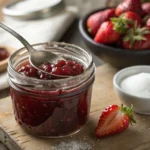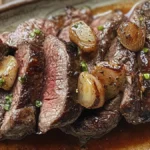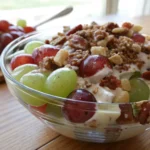“Is strawberry jam better with or without pectin?”, When it comes to homemade strawberry jam, this question often arises. Both methods have their advocates, and each approach offers distinct advantages depending on what you’re looking for in your jam. Whether you’re a seasoned jam-maker or a first-timer, understanding the role of pectin and how it affects the consistency and flavor of your jam, can help you make a more informed choice. This article will explore both methods—using pectin and going without it, so you can decide which works best for your homemade jam-making process.
Table of Contents
What is Pectin?
Pectin is a naturally occurring substance in many fruits, particularly in the peels, seeds, and cores of apples, citrus fruits, and berries. When combined with sugar and acid, it is a type of soluble fiber that helps create the gel-like consistency needed for jam and jelly. Without pectin, strawberry jam would be more like a syrup than a thick spread.
So, Is strawberry jam good with or without pectin?
How Does It Affect Strawberry Jam?
Pectin thereby helps the strawberry jam achieve the desired texture. It binds with the sugars and ac, which means the jam is thick and sets perfectly. This is even more important to some fruits, such as strawberries, which are naturally lower in pectin than apples or citrus fruits. Without added pectin, making strawberry jam can be more time-consuming, as you need to cook the jam longer to allow it to thicken naturally.
When added to strawberry jam, pectin speeds up the setting process, ensuring the jam reaches the right consistency more quickly. Additionally, pectin can help the jam hold its shape longer and avoid becoming too runny over time. This is why many jam recipes—particularly those intended for canning—recommend the addition of commercial pectin to ensure a reliable texture and shelf life.
Pectin comes in two main forms: liquid and powdered. Both types work similarly in jam-making, but the powdered form is the most common. Thus, adding pectin to the jam mixture increases the natural gelling power gained from the strawberries, giving a firmer and more spreadable result.
Therefore, jam-making does not require external pectin, natural pectin should suffice, coupled with long boiling, to create the desired jam consistency. While this method can produce a more authentic, homemade flavor, the texture may not be as thick and consistent as a pectin-based jam.
Ultimately, whether strawberry jam is better with or without pectin, depends on your preferences regarding texture, cooking time, and the level of fruit flavor you want to preserve. Pectin helps deliver predictable, consistent results while skipping it can offer a more natural, traditional approach to jam-making.
Benefits of Using Pectin in Strawberry Jam
When making strawberry jam, the question “Is strawberry jam better with or without pectin?” might be easier for those seeking reliability and speed. One major benefit of using pectin is achieving a thicker, more consistent texture in less time. Pectin is an excellent setting agent, especially for fruits like strawberries that are naturally low in pectin. This means your jam will have that perfect, spreadable consistency without extended cooking.
Using pectin also speeds up the process. Strawberry jam using pectin cooks quickly and is attractive to those wanting instant results. Pectin also preserves the strawberries’ natural flavor and ensures the jam sets every time.
Benefits of using pectin:
- Spreadable, thick all the way through
- Setting time is faster; therefore, cooking time is shorter.
- Reliable, consistent results.
- The jam needs less time to cool and set.
A Disadvantage of Pectin for Strawberry Jam
Strawberry jam has many benefits, but is it best made with or without pectin? Some avoid it for a few reasons. Commercial pectin comes with an additional cost, making it a less preferable choice for those with budget constraints interested in jam-making. Furthermore, while pectin does help the jam set quickly, it can sometimes cause the texture to feel a bit artificial if too much is used.
Another potential downside is the slight alteration of the jam’s flavor. Although pectin is generally flavor-neutral, some people feel its use can diminish the fresh, pure taste of the strawberries. For those who prefer strawberries’ natural, unaltered flavor, there may be better options than pectin.
Drawbacks of using pectin:
- Cost and availability of pectin.
- It can alter the natural fruit flavor if used excessively.
- Some may feel the texture needs to be thicker or artificial.
Is Strawberry Jam Better Without Pectin?
Many home cooks wonder, “Is strawberry jam better without pectin?” The answer largely depends on your preferences for flavor, texture and the time you’re willing to invest in the process. While adding pectin speeds up the jam-making process, it guarantees a thicker texture, opting for a pectin-free recipe results in a more natural and authentic jam.
Strawberry jam made without pectin relies on the fruit’s natural pectin content to thicken the mixture. While strawberries contain some pectin, it’s usually not enough to form a thick gel. This means the jam must be cooked longer to achieve the desired consistency, which can take up to an hour or more. But for many, this longer cooking process is worth it for a richer fruit flavor that highlights the sweetness of the strawberries without any added chemicals or preservatives.
One of the main reasons some people prefer strawberry jam without pectin is because it retains more of the pure, unadulterated strawberry flavor. When added, pectin can sometimes mask the taste of the fruit, especially if used excessively. By skipping pectin, the jam has a more complex, intense fruit taste, which many people find more satisfying.
In addition, strawberry jam without pectin is easier and healthier since it does not require adding commercially designed additives. Each can appeal to those searching for a more “pure” jam without artificial ingredients. Moreover, because there is no pectin in play, we can dictate the sweetness level, adding as much or as little sugar as we’d like.
However, there are some drawbacks to making strawberry jam without pectin. The main challenge is that the texture may need to be more predictable. While pectin offers more consistent results, jam made without pectin can sometimes be runny if cooked longer. It’s also harder to know exactly when the jam will be ready, and there’s a risk of either undercooking (resulting in liquid jam), or overcooking (leading to a too-thick jam).
In conclusion, is strawberry jam better without pectin?
If you enjoy a longer, more hands-on process and prefer a natural, fruit-forward flavor, making strawberry jam without pectin can be the ideal choice. But pectin may be the way for those seeking a faster, more foolproof choice with consistent texture.
read more about The Ultimate Strawberry Jam Recipe: How to Make Perfect Jam from Scratch
Benefits of Making Strawberry Jam Without Pectin
For some, the allure of pectin-free jam is about simplicity and purity. When you make strawberry jam (strawberry, sugar, and lemon juice), you use only natural ingredients without adding chemicals or preservatives, which is advantageous for anyone trying to make a healthier rendition of packaged jams.
Plus, homemade jam without pectin offers a richer fruit flavor, because the strawberries have more time to break down and concentrate their sweetness. There’s also something satisfying about the longer process, where you can savor each stage of jam-making and feel more connected to it.
Key benefits of making strawberry jam without pectin:
1. More Natural and Healthier Ingredients
One of the primary reasons people choose to make strawberry jam without pectin is to avoid adding commercial pectin, a processed product. By opting for a pectin-free recipe, you’re relying entirely on the natural pectin content of the strawberries and the sugar to achieve the right texture. This means fewer chemicals and artificial additives in your jam, resulting in a healthier and more natural product.
Your jam is closer to a traditional, handmade preserve without added pectin. This approach can be the best choice for those seeking a more pure and minimally processed option. Additionally, you have complete control over the sweetness level, as you can adjust the amount of sugar to suit your preferences without being bound by the requirements of a pectin-based recipe.
2. Richer, More Intense Strawberry Flavor
Is strawberry jam better without pectin? Many enthusiasts believe the lack of commercial pectin allows for a richer fruit flavor. Pectin can sometimes interfere with the true taste of the strawberries, especially if too much is used. Skipping the pectin preserves the natural strawberry essence, allowing the jam to taste like fresh, ripe strawberries. The fruit flavor is more intense and authentic, giving you a truly homemade, full-bodied jam experience.
By cooking the strawberries down to a thick consistency without the aid of pectin, you concentrate the flavor and sweetness, making every spoonful taste even more like the original fruit.
3. A More Traditional, Hands-On Process
For those who enjoy the craft of jam-making, skipping pectin leads to a more traditional, slower process that many find rewarding. Making jam without pectin requires more patience, but this allows you to perfect your technique and become more attuned to the right cooking times. Simmering, which, if you love to eat jam, is the hours you can go to check the consistency, which will help you obtain the right texture in your jam.
It’s often much more in keeping with the roots of home canning, as making jam without pectin is a long tradition of making at home. This process is rewarding for those who like making things from scratch and feeling more connected to their creations.
4. Better for Small Batch or Seasonal Jam
Making Strawberry Jam without Pectin can be helpful for a person who tends to make small batches or save for seasonal fruits. This jam is made with fresh local strawberries, not store-bought pectin or other added preservatives. It goes a long way in having fresher fork jam that stands out fruit from the jam. It also allows the metering of jam-producing fruits or fruits to mellow into the jam. Also, it serves as a finer finisher in adjusting recipes based on the amount of fruit, since scales can be proportioned to the berries.
For those who make jam once a year during strawberry season, this method allows you to enjoy the full flavor of summer after the season has ended. It’s an excellent way to preserve the essence of the fruit naturally and straightforwardly.
5. Flexibility in Recipe Variations
Using pectin, you apply a certain recipe and can always stay consistent with the form or the amount of fruit. Because you’re not concerned about how the pectin will affect the final product, you can blend other fruits with strawberries, such as raspberries or blueberries, to make a mixed-fruit jam. Likewise, without requiring pectin, you can feel free to alter the consistency, cooking up chunkier or silkier jam as you see fit.
Drawbacks of Making Strawberry Jam Without Pectin
While making strawberry jam without pectin has advantages, there are a few challenges to consider. One of the biggest drawbacks is that it takes more time. Without the help of commercial pectin, you’ll need to cook the jam for much longer, sometimes up to an hour, to achieve the proper thickness. Plus, you need to ensure your jam sets properly the first time, which can be a source of frustration for novice jam-makers.
Plus, jam with pectin tends to be more reliable. Though the stabilizer is added, the runny or excessively thick jam rounds of ardency might differ.
Drawbacks of making strawberry jam without pectin:
- Longyou’llking time is required.
- Less predictable results—jam may not set correctly.
- Risk of runny jam if not cooked properly.
How to Make Strawberry Jam With and Without Pectin
Whether you choose to use pectin or not, the process of making strawberry jam is similar. Here’s a basic overview of both methods:
- With Pectin: Combine strawberries, sugar, lemon juice, and commercial pectin. Cook over medium heat until the jam thickens and passes the plate test.
- Without Pectin: Combine strawberries, sugar, and lemon juice. Cook the mixture over low heat for an extended period, stirring often, until it reaches the desired consistency.
The main difference lies in the cooking time and the use of pectin; your jam will set more quickly, while without pectin, you’ll need to cook it longer to reduce the liquid and thicken it.
Which Method is Best for You: With or Without Pectin?
Ultimately, whether strawberry jam is better with or without pectin depends on personal preference. If you’re short on time and want a consistent, quick result, pectin is the best choice. On the other hand, if you’re looking for a more natural, traditional jam-making experience, making jam without pectin is the place to go.
Can You Substitute Pectin in Strawberry Jam?
Yes, if you prefer not to use commercial Pectin, there are several natural alternatives. You can use apple peels, citrus (naturally high in Pectin), or even granny your apples, which contain natural Pectin and can help your jam thicken.
FAQ Section: Is Strawberry you reenter with or Without Pectin?
What is the difference between jam with Pectin and jam without Pectin?
Jam with pectin sets faster and has a thicker, more consistent texture, while jam without Pectin takes longer to cook and has a more natural, fruit-forward flavor.
Does strawberry jam need Pectin?
No, strawberry jam doesn’t require Pectin. It can be set naturally using the fruit’s Pectin, but achieving the desired consistency may take longer.
Can I make strawberry jam without Pectin and still get a good result?
Yes, you can make strawberry jam without Pectin and still get a good result, but it may require more cooking time and careful attention to ensure it thickens properly.
How will my jam be set without Pectin?
Without Pectin, the jam will be set by cooking it longer to concentrate the natural sugars and acids in the fruit.
Can I make jam without Pectin, which also means less sugar?
- Yes, you can indeed use lesser amounts of sugar when preparing strawberry jam without Pectin. Both preservation and texture are typically addressed through Sugar, so using less sugar will alter the consistency of the jam.
Conclusion
Plus, you need to ensure your jam sets properly the first time, which can be a source of frustration for novice jam-makers.
Plus, jam with Pectin tends to be more reliable. Though the stabilizer is added, rounds of ardency, such as the runny or excessively thick jam, might differ. If you prefer a natural, homemade approach with a richer fruit flavor and a more traditional feel, making jam without Pectin might be your choice. Whatever method you choose, homemade strawberry jam—whether with or without Pectin—is always a delicious treat.






